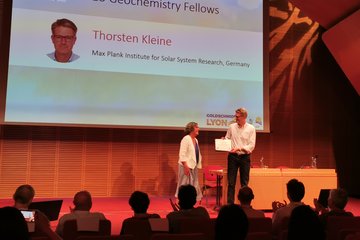Alle Typen
21.
Zeitschriftenartikel
Reduced Atmospheric Ion Escape Above Martian Crustal Magnetic Fields. Geophysical Research Letters (21), S. 11764 - 11772 (2019)
22.
Zeitschriftenartikel
Thin Current Sheets of Sub‐ion Scales observed by MAVEN in the Martian Magnetotail. Geophysical Research Letters 46 (12), S. 6214 - 6222 (2019)
23.
Zeitschriftenartikel
The Relationship Between Photoelectron Boundary and Steep Electron Density Gradient on Mars: MAVEN Observations. Journal of Geophysical Research: Space Physics 124 (10), S. 8015 - 8022 (2019)
24.
Zeitschriftenartikel
Solar Wind Deflection by Mass Loading in the Martian Magnetosheath Based on MAVEN Observations. Geophysical Research Letters 45 (6), S. 2574 - 2579 (2018)
25.
Zeitschriftenartikel
Martian ionosphere observed by MAVEN. 3. Influence of solar wind and IMF on upper ionosphere. Planetary and Space Science 160, S. 56 - 65 (2018)
26.
Zeitschriftenartikel
Multispecies and Multifluid MHD Approaches for the Study of Ionospheric Escape at Mars. Journal of Geophysical Research: Space Physics 123 (9), S. 7370 - 7383 (2018)
27.
Zeitschriftenartikel
The Structure of Martian Magnetosphere at the Dayside Terminator Region as Observed on MAVEN Spacecraft. Journal of Geophysical Research: Space Physics 123 (4), S. 2679 - 2695 (2018)
28.
Zeitschriftenartikel
Effects of solar irradiance on the upper ionosphere and oxygen ion escape at Mars: MAVEN observations. Journal Geophysical Research 122, S. 7142 - 7152 (2017)
29.
Zeitschriftenartikel
Martian ionosphere observed by Mars Express. 2. Influence of solar irradiance on upper ionosphere and escape fluxes. Planetary and Space Science 145, S. 1 - 8 (2017)
30.
Zeitschriftenartikel
The Effect of Solar Wind Variations on the Escape of Oxygen Ions From Mars Through Different Channels: MAVEN Observations. Journal of Geophysical Research: Space Physics 122 (11), S. 285 - 301 (2017)
31.
Zeitschriftenartikel
Initial Analysis of Ion Fluxes in the Magnetotail of Mars Based on Simultaneous Measurements on Mars Express and Maven. Solar System Research 51, S. 335 - 346 (2017)
32.
Zeitschriftenartikel
Ultra low frequency waves at Venus: Observations by the Venus Express spacecraft. Planetary and Space Science 146, S. 55 - 65 (2017)
33.
Zeitschriftenartikel
Imprints of quasi-adiabatic ion dynamics on the current sheet structures observed in the Martian magnetotail by MAVEN. Journal Geophysical Research 122 (10), S. 10176 - 10193 (2017)
34.
Zeitschriftenartikel
Structure of the Current Sheets in the Near-Mars Magnetotail. Maven Observations. Solar System Research 51, S. 347 - 361 (2017)
35.
Zeitschriftenartikel
Analysis of dayside magnetosphere of Mars: High mass loading case as observed on MAVEN spacecraft. Planetary and Space Science 147, S. 28 - 37 (2017)
36.
Zeitschriftenartikel
Ablation of Venusian oxygen ions by unshocked solar wind. Science Bulletin 62 (24), S. 1669 - 1672 (2017)
37.
Zeitschriftenartikel
An induced global magnetic field looping around the magnetotail of Venus. Journal Geophysical Research 121 (1), S. 688 - 698 (2016)
38.
Zeitschriftenartikel
Martian ionosphere observed by Mars Express, 1. Influence of the crustal magnetic fields. Planetary and Space Science 124, S. 62 - 75 (2016)
39.
Zeitschriftenartikel
The morphology of the topside ionosphere of Mars under different solar wind conditions: Results of a multi-instrument observing campaign by Mars Express in 2010. Planetary and Space Science 120, S. 24 - 34 (2016)
40.
Zeitschriftenartikel
Solar zenith angle-dependent asymmetries in Venusian bow shock location revealed by Venus Express. Journal Geophysical Research 120, S. 4446 - 4451 (2015)











